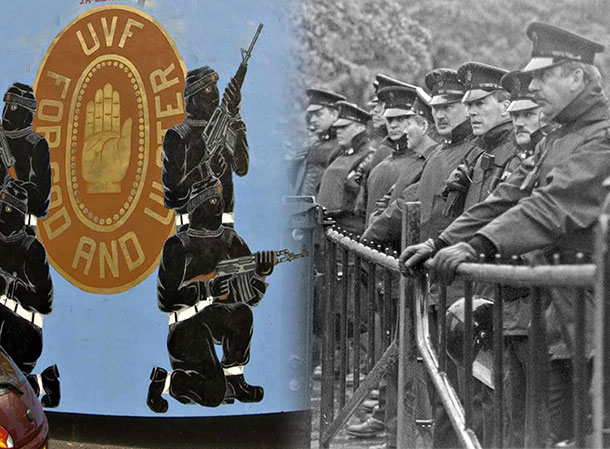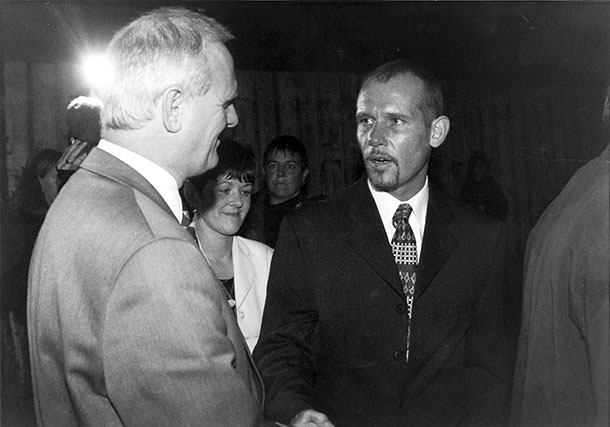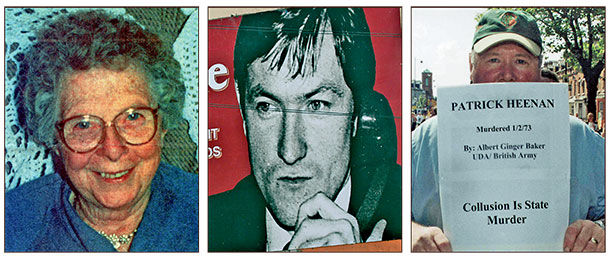1 June 2015 Edition
Spotlight on Britain's undercover war
RUC Special Branch unit tampered with evidence and investigations into 60 killings carried out by state agents

• The use of unionist killer gangs was a central plank of British Government policy
"The available evidence suggests agents of the state devised and operated a policy of extra-judicial execution, the essential feature of which was that loyalist terrorist organisations were infiltrated, resourced and manipulated in order to murder individuals identified by the state and their agents as suitable for assassination" – Finucane family barrister Barry McDonald QC

'Balance' tips over inconvenient truth
AN PHOBLACHT has been told that BBC bosses insisted that the Spotlight programme broadcast on Tuesday 12 May that highlighted the existence of a secretive forensics unit controlled by Special Branch and which effectively stymied the investigations into multiple killings by unionist gunman Billy Wright's UVF death squad had to be 'balanced'.
While the bulk of the attacks covered in the programme were carried out by Wright's killer gangs, a large part of the programme focused on the killing of two Royal Ulster Constabulary members by the IRA.
Programme-makers uncovered evidence that RUC Special Branch handed two handguns back to an agent they were running who returned them to an IRA arms dump.
The weapons were subsequently used to shoot dead the two RUC men, Gary Meyer and John Beckett, in Belfast city centre.
While acknowledging the tragedy for the families of the two men, our source maintains that the programme, by seeking to 'balance' it by showing the RUC Special Branch as the proverbial 'bad apples' using agents on both sides, thus reinforcing the British narrative of the conflict as a sectarian war.
It therefore sidestepped the inconvenient truth that unionist death squads were operating as an integral part of the British military and counter-insurgency strategy and were being run systematically by Special Branch and British Military Intelligence – all commanded from and accountable to Whitehall and Downing Street.

• UVF/LVF leader Billy Wright with DUP MP Willie McCrea. Inset: British Army agent Brian Nelson
A SECRET RUC Special Branch forensics unit is being investigated by the Police Ombudsman's office amid growing calls for the British Government to come clean on its use of unionist killer gangs in the North.
The BBC Spotlight investigative programme broadcast on Tuesday 12 May revealed that the Police Ombudsman's office is investigating the role of Weapons and Explosives Research Centre (WERC) unit and accusations that it tampered with evidence and hampered investigations into some 60 killings. The WERC was run by the RUC Special Branch.
Paul Holmes, Director of the Police Ombudsman's Historic Investigations Unit, told Spotlight it currently has “four complex criminal investigations” ongoing. “In each of those investigations,” he told the BBC, “we are examining issues around the activities of WERC and weapons that were used to kill over 60 people.”
Of particular interest are the assassinations of 18 people in the areas of mid-Ulster, south Derry and east Tyrone carried out by the Ulster Volunteer Force then under the control of notorious sectarian killer Billy Wright.
While the BBC reported that the activities of Special Branch and WERC were being investigated by the Police Ombudsman, the existence of the unit and allegations involving the tampering with evidence emerged in late 2013 during the inquest into the death of Dungannon pensioner Roseann Mallon in May 1994.
Reports say that weapons were handed over to WERC personnel, who were not properly qualified in forensic science, before they went to the North's forensic laboratory for examination.
While in the hands of WERC operatives, the weapons were tampered with so that inaccurate findings were produced.
On finding out that “incorrect forensic evidence concerning the weapon and ammunition used in the murder [of Roseann Mallon] had been given”, Mike Ritchie of the Relatives for Justice victims support NGO said, Judge Weir adjourned the inquest.
The original ballistics tests on the weapon used to kill Roseann Mallon (a VZ 58, the Czech version of an AK47 assault rifle, part of a consignment brought into Ireland by top British Army agent Brian Nelson) produced by WERC indicated the gun was not linked to any other attacks. It later emerged that the rifle had in fact been used in multiple killings in the east Tyrone area.
Barry McDonald, counsel for the Mallon family, said in court:
“Special Branch may have tampered with the weapon used to murder Roseann Mallon before it was examined by forensic experts.
“An abrasive material, possibly sandpaper, was used to distort the firing pin of the Czech-bought assault rifle which has also been linked to eight other loyalist shootings through analysis of bullet casings.
Jonathan Greer, from the North's Forensic Laboratory, examined the gun in 2013 and acknowledged that this may have been a deliberate attempt to hinder the identification process.
“It looked as if somebody had taken the firing pin and abraded it . . . with sandpaper,” said Greer. “It could have been part of a cleaning regime or possibly to make it look like it came from a different weapon.”
His analysis of the evidence was confirmed by an independent expert commissioned by the Mallon family to also assess the material.
According to Relatives for Justice, WERC, was established in 1981 even though it and its predecessor, the Data Reference Centre, “had been in operation since 1971”. But it wasn't until 2006 that WERC was referred to in court documents.
In 1994, WERC operated alongside the NI Forensic Science Laboratory (NIFSL) but its RUC-controlled personnel examined weaponry before it was handed over to the civilian forensic scientists for analysis.
It is also worth noting that, in 2009, WERC was moved under the management structure of C6 Scientific Support (a branch of the Crime Operations Department of the PSNI) and changed its name to the Centre for Information on Firearms and Explosives (CIFEx) – clearly another case of the old guard from the days of the RUC retaining positions of influence within the PSNI.
The Mallon inquest also heard that WERC operatives were not qualified.
Two WERC employees who gave evidence, David Bradley and “C”, admitted that they didn't keep records or working notes to demonstrate how they arrived at their findings.
It was Bradley, a former British Army corporal, who examined the weapon recovered near Loughgall which was used to kill Charles and Teresa Fox near The Moy, County Tyrone, in 1992 and failed to find any matches from the bullets and bullet casings found at the scenes of various attacks during the time it was in the hands of the unionist killers.
It was subsequently established, in 2013, that the weapon had a long history of use in several killings:
November 1988 – Phelim McNally
November 1989 – Liam Ryan and Michael Devlin
October 1990 – Tommy Casey
November 1990 – Malachy McIvor
March 1991 – John Quinn, Dwayne O'Donnell, Malcolm Nugent and Tommy Armstrong
May 1994 – Charles and Teresa Fox and Roseann Mallon

• Victims: Roseann Mallon, Pat Finucane and Patrick Heenan, were killed in attacks by unionist gangs in collusion with British state forces
Unbelievably, Bradley who headed up the WERC team, based at Seapark in Carrickfergus, County Antrim, had no formal academic qualifications. Prior to his employment as a forensic operative, he drove a crane in Harland & Wolff shipyard.
Justifying his credentials, he told the court:
“I did not have any professional qualifications. I had four years' experience in the Forensic Science Firearms Laboratory and by that stage [1993/4] almost 18 years' experience in microscopy.”
The revelations concerning the WERC operation come as pressure is mounting on the British Government over its deployment of unionist killer gangs as a central plank of its military strategy in the North, especially the role of British Army counter-insurgency guru General Frank Kitson.
Kitson and the British Ministry of Defence were cited in a writ issued in April this year when the family of Patrick Heenan, killed in a UDA attack in 1973, travelled to London to open legal proceedings against the man who was head of British military operations in the North in the early 1970s.
Relatives for Justice, who are supporting the family, say that Kitson established the “policy framework and enabling architecture of pseudo gangs and counter-gangs involved in countless sectarian murders and political assassinations involving agents recruited and deployed” by the state.
One such group, the Military Reaction Force (MRF), was a covert British Army unit responsible for numerous killings of nationalists, mostly in Belfast.
Slain solicitor Pat Finucane's wife, Geraldine, and his family are seeking a judicial review of British Prime Minister David Cameron's decision to authorise the de Silva review rather than hold the independent investigation the British Government signed up to in the 2006 St Andrew's Agreement.
The Finucane family barrister, Barry McDonald QC, told the hearing on Monday 11 May:
“The available evidence suggests agents of the state devised and operated a policy of extra-judicial execution, the essential feature of which was that loyalist terrorist organisations were infiltrated, resourced and manipulated in order to murder individuals identified by the state and their agents as suitable for assassination.”
McDonald also drew attention to correspondence between senior civil servants and David Cameron prior to his decision to order the de Silva review in which an adviser to the British Prime Minister described Finucane as “another republican lawyer”.
Speaking to An Phoblacht TV, John Finucane, Pat Finucane's son, rebutted the British narrative that the system “broke down” in the killing of his father and others. He said “the system was working perfectly well – it was designed to target, kill and provide propaganda” to cover up the British agenda.
To quote General Frank Kitson himself advocating how government, the law, the judiciary and the media had to be moulded to defeat 'the enemy':
“Everything done by a government and its agents in combating insurgency must be legitimate. But this does not mean that the Government must work within exactly the same set of laws during an emergency as existed beforehand.
“The law should be used as just another weapon in the Government’s arsenal, in which case it becomes little more than a propaganda cover for the disposal of unwanted members of the public.”




